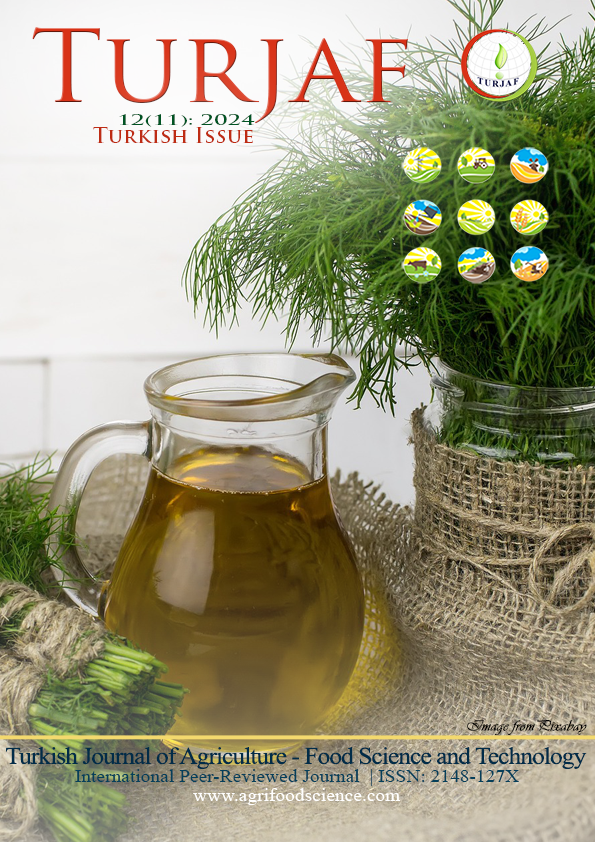Influence of Doses and Application Methods of Paclobutrazol on Seedling Quality in Cucumber
DOI:
https://doi.org/10.24925/turjaf.v12i11.1908-1913.6950Keywords:
Seedling height, stem diameter, quality, seedling fresh weight, seedling dry weightAbstract
In this study, the effect of different applications of paclobutrazol on seedling quality in cucumber was investigated. In the trial, 30, 40, 50 and 60 ppm doses of paclobutrazol were applied in 2 different amounts (0.5-1.0 ml) and in 2 different ways. The first application was made when the cotyledon leaves were parallel to the ground and no application was made afterwards (1+0). Paclobutrazol was given twice (1+1), the first application being when the cotyledon leaves were parallel to the ground and the second application being when the first true leaves reached 0.5 cm in diameter. In control plots, plants were sprayed with distilled water. Hoagland nutrient solution was modified and used to fertilize the seedlings. The pH of the solution was adjusted to 6.3±2 during the seedling growing period. Seedlings were harvested on the 35th day and observations were made. In the study, seedling height (cm), stem length (cm), stem diameter (mm), number of leaves, seedling fresh weight (g), seedling dry weight (g), root fresh weight (g) and root dry weight (g) were examined. Paclobutrazol applications caused a significant shortening in seedling height and stem length. As the amount of paclobutrazol increased, the decrease in seedling height and stem length continued. In the trial, giving 30 and 40 ppm paclobutrazol as 0.5 ml per seedling and 1+1 application was determined to be the most effective result. No significant relationship was found between paclobutrazol applications and stem diameter. Similarly, no relationship was found between applications and the number of leaves. In conclusion, while paclobutrazol significantly increases seedling quality, it also causes significant declines in seedling quality depending on the application method, application dose and amount.
References
Caprita, A., & Caprita, R. (2005). Plant growth retardants for the treatment of vegetables used as raw materials for the food Industry. Agroalimentary Processes and Technologies, 11 ( 1), 173-178.
Di Benedetto, A., & Klasman, R. (2007). The effects of plug cell volume, paclobutrazol height control and the transplant stage on the post-transplant growth of Impatiens wallerana pot plant. European Journal of Horticultural Science, 193- 197.
Flores, L.L.C., Alcaraz, T.D.J.V., Ruvalcaba, L.P., Valdés, T.D., Tafoya, F.A., Torres, N.D.Z., & Juárez, M.G.Y. (2018). Paclobutrazol applied 28 on cotyledonal leaves and quality of cucumber, squash, melon and watermelon seedlings. Agricultural Sciences, 9(03), 264 – 71.
Geboloğlu, N., Durukan, A., Sağlam, N., Doksöz, S., Şahin, S., & Yılmaz, E. (2015). Patlıcanda fide gelişimi ve fide kalitesi ile paclobutrazol uygulamaları arasındaki ilişkiler. Tarım Bilimleri Araştırma Dergisi, 8(1), 62-66.
Geboloğlu, N., Kum, A. D., Şahın, S., Boncukçu, S. D., & Sağlam, N. (2016). Paklobutrazolun marulda fide boyu ve kalite özelliklerine etkisi. Tarım Bilimleri Araştırma Dergisi, 9(2), 26-29.
Globerson, D., Mills, M., Ben Yehuda, J. R. W., Levy, M., & Eliassy, R. (1988). Effects of paclobutrazol (PP333) on flowering and seed production of onion, cucumber and carrot. In IV International Symposium on Seed. Research in Horticulture 253: 63-72.
Kazemi, M. (2013). Response of cucumber plants to foliar application of calcium chloride and paclobutrazol under greenhouse conditions. Bulletin of Environment, Pharmacology and Life Sciences Bull. Env. Pharmacol. Life Sci., 2 (11), 15-18.
Latimer, J. G. (1992). Drought, paclobutrazol, abscisic acid, and gibberellic acid as alternatives to daminozide in tomato transplant production. Journal of the American Society for Horticultural Science, 117 (2), 243-247.
Latimer, J. G. (1994). Brushing Reduces Thrips and Aphid Populations on Some Greenhouse-grown Vegetable Transplants. Journal of the American Society for Horticultural Science, 29 (11). 1279 -1281.
Liu, J., Leatherwood, W. R., & Mattson, N. S. (2012). Irrigation method and fertilizer concentration differentially alter growth of vegetable transplants. Hort Technology, 22(1), 56-63.
Magnitskiy, S. V. (2004). Controlling Seedling Height by Treating Seeds With Plant Growth Regulators. (Doctoral dissertation), The Ohio State University.
Özgur, M. (2011). Growth control in cucumber seedlings by growth regulators application. Bulgarian Journal of Agricultural Science, 17 (1), 99-106.
Pasian, C. C., & Bennett, M. A. (2001). Paclobutrazol soaked marigold, geranium, and tomato seeds produce short seedlings. HortScience, 36 (4), 721-723.
Rademacher, W. (2000). Growth retardants: Effects on gibberellin biosynthesis and other metabolic pathways. Annu. Rev. Plant Physiol. Plant Mol. Biol., 51, 501–31.
Rajapakse, N. C., & Li, S. (2002). Exclusion of far red light by photoselective greenhouse films reduces height of vegetable seedlings. In XXVI International Horticultural Congress: Issues and Advances in Transplant Production and Stand Establishment Research 631 (pp. 193-199).
Rajapakse, N. C., Young, R. E., McMahon, M. J., & Oi, R. (1999). Plant height control by photoselective filters: current status and future prospects. HortTechnology, 9(4), 618-624.
Runcle, E. (2010). Height control for vegetable transplants. Greenhouse Product News, 2, 50.
Wang, Y. T., & Gregg, L. L. (1990). Uniconazole controls growth and yield of greenhouse tomato. Scientia Horticulturae, 43(1), 55-62.
Westwood, M.N. (1993). Hormones and Growth Regulators, Temperate Zone Pomology: Physiology and Culture. Timber Press Inc, Portland, Oregon, USA.
Whipker, B. E., & Dasoju, S. (1998). Potted sunflower growth and flowering responses to foliar applications of daminozide, paclobutrazol, and uniconazole. HortTechnology, 8 (1), 86-88.
Whitaker, B. D., & Wang, C. Y. (1987). Effect of paclobutrazol and chilling on leaf membrane lipids in cucumber seedlings. Physiologia Plantarum, 70(3), 404-411.
Zhu, L. J., Deng, X. G., Zou, L. J., Wu, J. Q., Zhang, D. W. & Lin, H. H. (2016). Proanthocyanidins accelerate the germination of cucumber (Cucumis sativus L.) seeds. Journal of plant biology, 59(2), 143-151.
Downloads
Published
How to Cite
Issue
Section
License
This work is licensed under a Creative Commons Attribution-NonCommercial 4.0 International License.









